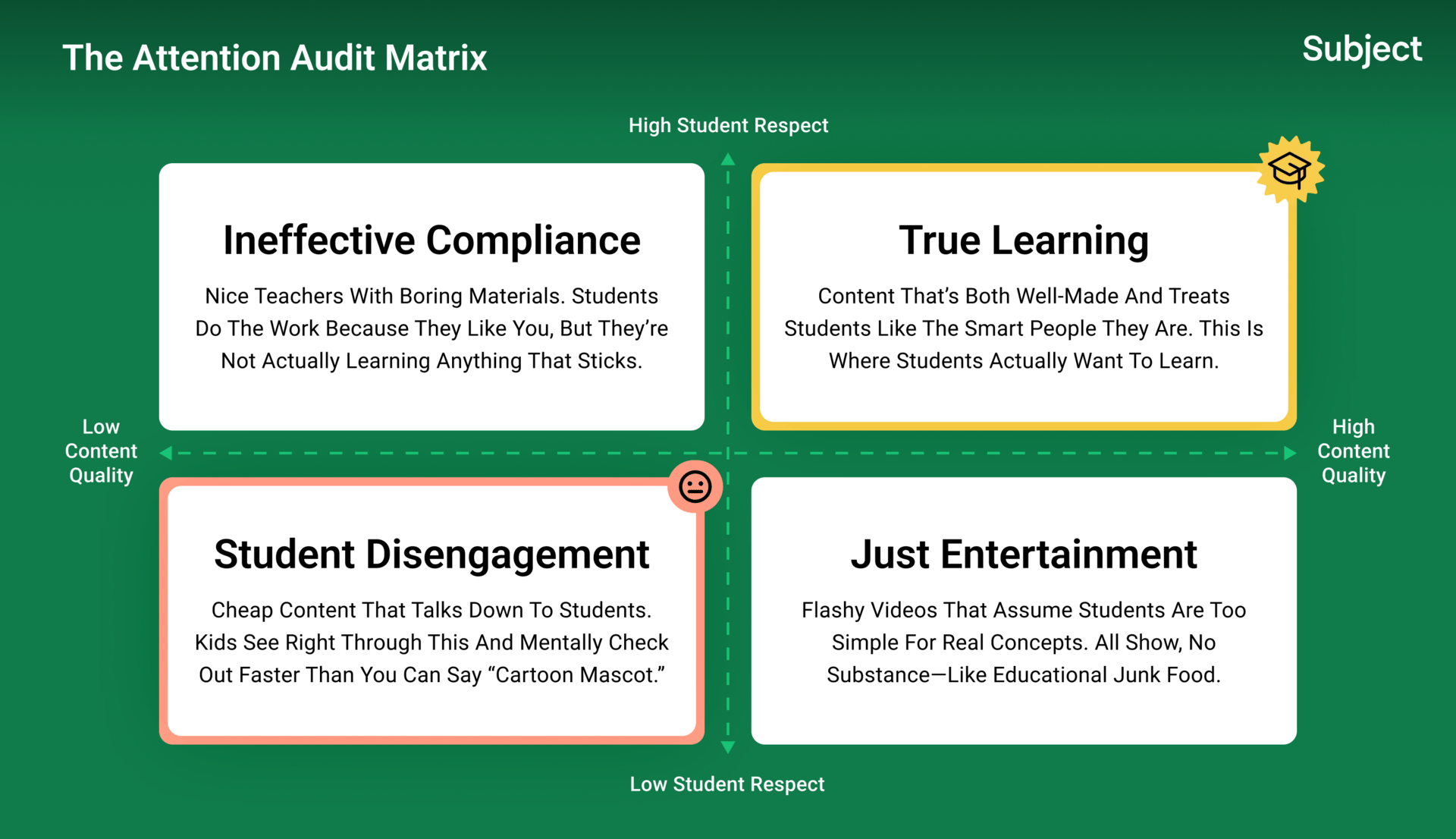
Remember when everyone said kids these days can't focus?
Well, turns out those same kids will watch Kai Cenat stream himself sleeping for 30 straight days, but mentally peace out during your PowerPoint after slide three.
Kevin Ostrowski and Sam Wasylenko just graduated college carrying something rarer than a perfect GPA: They actually remember what it's like to be students. After spending months interviewing classmates who went from failing everything to walking across graduation stages, they uncovered a pattern that's about to make every EdTech CEO sweat profusely during board meetings.
Students aren't ditching class because they can't pay attention. They're leaving because nobody bothered to make content worth their time.
"I can sit and watch a YouTube video that's four... or a podcast that's four and a half hours long," Kevin explains from a recent interview. "I think teachers and educators tell themselves that [students have short-attention spans], so they don't have to be more entertaining and try harder."
Luckily for all of us, the creative duo dropped the Axis of Attention—a diagnostic tool that explains why students will marathon entire Netflix seasons, but treat your carefully crafted lesson plans like dental surgery without novocaine.
More on that below.

Here’s what’s on the dashboard this week:
Today’s Deep Dive: Students crave respect, not baby talk
Reading Rainbow: Desks die, principals win, students lie
From Our Desk: Catch us IRL + hear about our latest features
Watch of the Week: There’s wisdom in “The Office”?

Students crave respect, not baby talk
Kevin and Sam didn't set out to expose the education industry's biggest failure.
They just happened to graduate with working memories of sitting through content designed by people who forgot what it was like to be a kid sitting at a desk for hours on end.
While interviewing students who pulled themselves from falling behind in class to graduating with success, they learned that students aren't running from hard material.
They're fleeing from being treated like they're “stupid,” as Sam puts it.
"People are still constructing these classes as if you need to stretch, like, a really basic concept out really long," Sam recalls from one particularly painful interview. "It feels like they're bored now because they aren't being engaged and met at the level that they're at."
Kevin also shared the uncomfortable truth.
"If you wouldn't personally sit through that lecture and take notes and learn something from it at that age, you probably shouldn't be talking about it."
Their game-changing discovery? Student engagement lives at the intersection of two things EdTech companies pretend don't matter: Content Quality and Student Respect.
Here’s what each quadrant in the Axis of Attention represents:

Student Disengagement = Low Quality + Low Respect
Welcome to traditional EdTech, where cartoon mascots explain photosynthesis like they're talking to toddlers. "You can tell they didn't really care,” Sam says, referring to some of the EdTech content they’ve seen. “They were just trying to sell a contract."
Ineffective Compliance = Low Quality + High Respect
Sweet teachers serving stale content with genuine kindness. (We still love you!) Students show up out of politeness but learn nothing they'll remember past the quiz. It's educational comfort food—feels nice, zero nutritional value.
Just Entertainment = High Quality + Low Respect
Slick videos that assume students need constant hand-holding. All fireworks, no substance. Students watch because it's pretty, but walk away empty-handed.
True Learning = High Quality + High Respect
This is where magic actually happens. It’s the holy grail where students actually want to be. Students immediately recognize when content was made for them rather than at them. "I can tell that this platform was made for us," Sam said about encountering well-designed educational tools. "It feels like they respect the student. They're not stupid."
Students have already moved on from educational content that looks like it was designed in 1987. They're demanding Netflix production values with intellectual respect. Now, every school district faces the same choice: meet students where they are, or keep wondering why they're mentally shopping on Amazon during your presentations.
Find the three-step process to using Sam and Kevin’s Axis of Attention in our latest playbook.

When Desks Go Rogue: A teacher in Canada ditched all 18 desks in favor of couches, floor cushions, and standing workstations—and now other teachers send struggling students to her classroom as a "sanctuary" where they can actually focus. Rumor has it that focus skyrockets when kids stop sitting like Victorian clerks.
Principal Power Moves: Veteran principals reveal their secrets: be visible, create emotional support systems, maintain consistent expectations, and share leadership responsibilities. (Basically Ted Lasso but with budget meetings and standardized tests.)
The Great Engagement Illusion: A Discovery Education survey reveals that 63% of students think they're highly engaged in school, but only 45% of teachers agree. Even more telling, students consistently rate themselves as engaged while throwing their classmates under the bus, proving that self-awareness remains as elusive as finding a working copier during finals week.
The Broadway Green Revolution Hits Elementary School: A Tony-nominated actress created a climate change play for kids using recycled Broadway props, proving that cardboard from "Hadestown" can teach sustainability better than most textbooks. Let this be proof that you can upcycle your trauma and your set design.

Catch Us IRL This Month: We're hitting the conference circuit with our laptop stickers and questionable coffee consumption. Come say hi!
Find us at the:
AASA AI Summit (11/18 - 11/19)
Joel Hames, our Chief Product Officer, will be presenting in the breakout session The Great Education Reset: Operating in the Age of AI on Wednesday morning!
WSSDA Annual Conference (11/20 - 11/22)
MASA Small & Rural Conference (11/24 - 11/25)
Our New Features Are Live! Session Logs are up and running, showing exactly when students zone out during your lessons (sorry, but also you're welcome). Our Guided Notes —now with auto-save and offline access—convert passive video watching into active learning with AI-powered fill-in-the-blanks. And our Teacher Visibility feature lets you see who's actually taking notes versus who's pretending to pay attention from the Scorebook. (Because student engagement is always the top priority.)


Our pick of the week: The Office
Why We’re Obsessed: Jim Harper mastered the art of making mundane office life entertaining through creative problem-solving and deadpan humor (exactly what educators need when dealing with administrative chaos). Plus, watching The Office makes you realize your workplace drama is actually pretty tame (no one's ever put anyone's stapler in Jell-O).
Recommended lesson integration:
Creative writing through character development (Grades 6-8) — Study Jim's pranks as masterclasses in narrative setup and payoff, because every good story needs a plan and a punchline.
Business communication skills (Grades 6-8) — Analyze effective vs. ineffective workplace interactions, using Michael Scott as the cautionary tale your students will actually remember.
Ethics and workplace dynamics (Grades 9-12) — Examine moral dilemmas through Jim's pranks and their consequences, teaching kids that actions have reactions (and sometimes those reactions are very angry Dwights).
Media literacy and documentary techniques (Grades 6-12) — Explore mockumentary style and "talking head" interviews, showing students how perspective shapes storytelling.
Economics and small business management (Grades 6-12) — Use Dunder Mifflin as a case study in what happens when management has no idea what they're doing.
Psychology of group dynamics (Grades 6-12) — Chart office relationships and power structures throughout the series, because understanding workplace politics starts early.
Public speaking and presentation skills (Grades 6-12) — Michael's conferences provide endless examples of what not to do, which is oddly the most effective way to teach effective communication.
Thank you for joining us for another edition of On The Subject. We’ll see you again in a week, with more stories from the hallways.
The Subject Team
Want to learn more about our curriculum offerings? Contact us today.
Share On The Subject!
{{rp_personalized_text}}
{{rp_upcoming_milestones}}
Or copy and share this link: {{rp_refer_url}}
